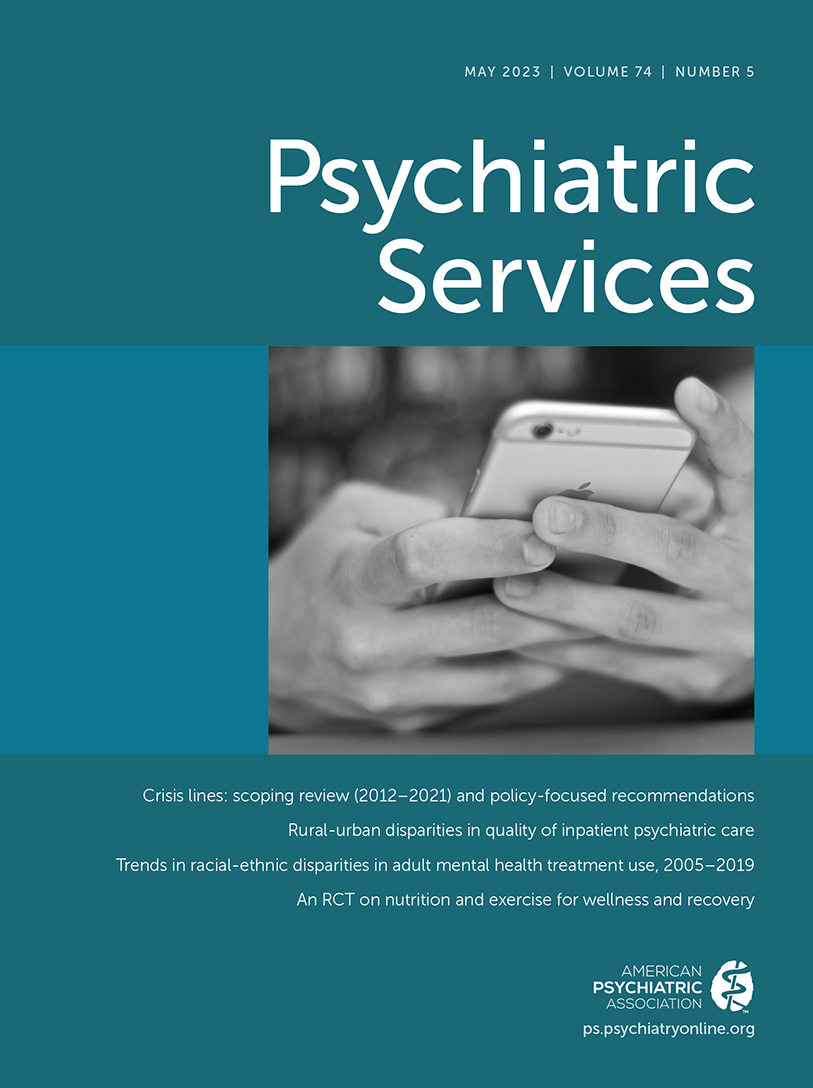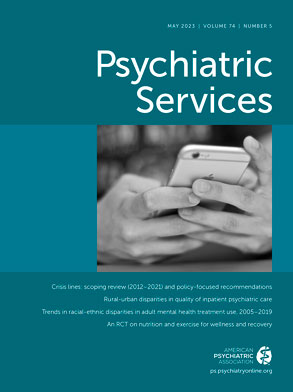Nutrition and Exercise for Wellness and Recovery: A Randomized Controlled Trial of a Community-Based Health Intervention
Abstract
Objective:
Methods:
Results:
Conclusions:
HIGHLIGHTS
Methods
Study Procedures
Inclusion and Exclusion Criteria
Study Enrollment and Retention
Intervention
Instructor training and supervision.
Intervention fidelity.
Control Condition
Measures
Statistical Analysis
Results
Intervention Fidelity and Attendance
Participant Baseline Characteristics and Equivalence of Study Conditions
| Total sample (N=113) | NEW-R (N=55) | Control (N=58) | ||||
|---|---|---|---|---|---|---|
| Characteristic | N | % | N | % | N | % |
| Gender | ||||||
| Male | 37 | 33 | 15 | 27 | 22 | 38 |
| Female | 73 | 65 | 39 | 71 | 34 | 59 |
| Transgender | 3 | 3 | 1 | 2 | 2 | 3 |
| Race and ethnicityb | ||||||
| Black, African American | 86 | 76 | 42 | 76 | 44 | 76 |
| White | 24 | 21 | 14 | 26 | 10 | 17 |
| Asian | 2 | 2 | 0 | — | 2 | 3 |
| American Indian | 8 | 7 | 4 | 7 | 4 | 7 |
| Native Hawaiian, Pacific Islander | 1 | 1 | 1 | 2 | 0 | — |
| Alaska Native | 1 | 1 | 0 | — | 1 | 2 |
| Latinx | 9 | 8 | 2 | 4 | 7 | 12 |
| Age (M±SD) | 47.1±12.4 | 48.0±12.6 | 46.2±12.1 | |||
| Educationc | ||||||
| Less than high school | 28 | 25 | 17 | 31 | 11 | 19 |
| High school graduate | 31 | 28 | 15 | 27 | 16 | 28 |
| Some college | 33 | 30 | 12 | 22 | 21 | 37 |
| College graduate | 20 | 18 | 11 | 20 | 9 | 16 |
| Employed | 9 | 8 | 4 | 7 | 5 | 9 |
| Marital status | ||||||
| Never married | 82 | 73 | 41 | 75 | 41 | 71 |
| Married or cohabiting | 4 | 4 | 1 | 2 | 3 | 5 |
| Divorced | 20 | 18 | 10 | 18 | 10 | 17 |
| Separated | 3 | 3 | 1 | 2 | 2 | 3 |
| Widowed | 4 | 4 | 2 | 4 | 2 | 3 |
| Living situationd | ||||||
| Own house or apartment | 83 | 75 | 44 | 82 | 39 | 68 |
| Home of friend or relative | 23 | 21 | 8 | 15 | 15 | 26 |
| Agency housing | 4 | 4 | 1 | 2 | 3 | 5 |
| Shelter or street | 1 | 1 | 1 | 2 | 0 | — |
| Diagnosisb | ||||||
| Schizophrenia or schizoaffective disorder | 57 | 50 | 26 | 47 | 31 | 53 |
| Depressive disorder | 43 | 38 | 20 | 36 | 23 | 40 |
| Bipolar disorder | 38 | 34 | 20 | 36 | 18 | 31 |
| Anxiety disorder | 26 | 23 | 12 | 22 | 14 | 24 |
| Self-reported history of difficulties with alcohol, recreational drugs, or misusing prescribed medications | 32 | 28 | 16 | 29 | 16 | 28 |
| Comorbid medical disordere | 99 | 88 | 47 | 86 | 52 | 90 |
| Current cigarette use | 30 | 27 | 15 | 27 | 15 | 26 |
| Currently taking a medication with risk of weight gain | 20 | 18 | 8 | 15 | 12 | 21 |
| Household annual incomef | ||||||
| <$10,000 | 61 | 56 | 30 | 57 | 31 | 54 |
| $10,000–$19,999 | 29 | 26 | 15 | 28 | 14 | 25 |
| ≥$20,000 | 20 | 18 | 8 | 15 | 12 | 21 |
| Insuranceb | ||||||
| Medicaid | 90 | 80 | 41 | 75 | 49 | 85 |
| Medicare | 46 | 41 | 20 | 36 | 26 | 45 |
| Private | 6 | 5 | 4 | 7 | 2 | 3 |
| Body mass index (kg/m2) | ||||||
| Overweight (25–29) | 22 | 19 | 8 | 15 | 14 | 24 |
| Obese (30–39) | 55 | 49 | 25 | 45 | 30 | 52 |
| Severely obese (≥40) | 36 | 32 | 22 | 40 | 14 | 24 |
| Perceived Competence Scale score (M±SD)g | 18.2±5.6 | 17.8±5.6 | 18.7±5.6 | |||
| Health-Promoting Lifestyle Profile total scale (M±SD)h | 64.3±11.6 | 63.8±12.0 | 64.8±11.4 | |||
| Nutrition subscalei | 22.3±4.9 | 22.2±5.1 | 22.4±4.7 | |||
| Spiritual growth subscalei | 26.3±5.4 | 25.7±5.6 | 26.8±5.2 | |||
| Physical activity subscalej | 15.7±4.7 | 15.8±4.7 | 15.5±4.7 | |||
| Weight in pounds (M±SD) | 232.2±46.5 | 239.1±52.7 | 225.6±39.2 | |||
Primary and Secondary Outcomes for the Intervention Versus Control Condition
| Outcome | Parameter estimate | SE | p |
|---|---|---|---|
| Perceived Competence Scale (assessing exercise and healthy diet) | |||
| Intercept | 24.44 | 3.61 | <.001 |
| Intervention | −.69 | 1.09 | .527 |
| Time | −.53 | .37 | .155 |
| Intervention × time | 1.24 | .54 | .024 |
| Health-Promoting Lifestyle Profile (HPLP) total scale | |||
| Intercept | 74.22 | 15.46 | <.001 |
| Intervention | −.66 | 2.38 | .781 |
| Time | −1.15 | .87 | .185 |
| Intervention × time | 2.62 | 1.27 | .040 |
| HPLP nutrition subscale | |||
| Intercept | 22.63 | 1.01 | <.001 |
| Intervention | .06 | .90 | .950 |
| Time | −.40 | .26 | .130 |
| Intervention × time | .79 | .38 | .041 |
| HPLP spiritual growth subscale | |||
| Intercept | 26.63 | 1.19 | <.001 |
| Intervention | −.74 | .98 | .450 |
| Time | −.42 | .27 | .127 |
| Intervention × time | .95 | .40 | .019 |
| HPLP physical activity subscale | |||
| Intercept | 15.42 | .60 | <.001 |
| Intervention | .66 | .86 | .446 |
| Time | .30 | .27 | .280 |
| Intervention × time | −.05 | .40 | .907 |
| Weight in pounds | |||
| Intercept | 173.24 | 32.88 | <.001 |
| Intervention | 14.30 | 8.88 | .110 |
| Time | 1.89 | .87 | .032 |
| Intervention × time | −1.96 | 1.28 | .128 |
| Weight in pounds at three responder sites onlyb | |||
| Intercept | 250.89 | 19.58 | <.001 |
| Intervention | 9.29 | 12.51 | .461 |
| Time | 1.58 | 1.15 | .173 |
| Intervention × time | −4.33 | 1.66 | .010 |
Site Differences in Weight Change

| Condition and site | Weight at baseline | Weight at postintervention | Change from baseline to postintervention | Weight at follow-up | Change from postintervention to follow-up | Change from baseline to follow-up | |||
|---|---|---|---|---|---|---|---|---|---|
| M | SD | M | SD | M | SD | ||||
| NEW-R | 239.1 | 52.7 | 237.3 | 56.5 | −1.8 | 239.0 | 59.1 | +1.7 | −.1 |
| Control | 225.6 | 39.2 | 224.9 | 40.0 | −.7 | 230.5 | 40.1 | +5.6 | +4.9 |
| NEW-R only | |||||||||
| Site 1 (outpatient clinic) | 259.2 | 45.1 | 262.6 | 49.0 | +3.4 | 271.0 | 48.9 | +8.4 | +11.8 |
| Site 2 (agency) | 237.9 | 67.7 | 237.3 | 73.6 | −.6 | 234.3 | 77.0 | −3.0 | −3.6 |
| Site 3 (agency) | 208.8 | 46.1 | 203.6 | 49.8 | −5.2 | 198.7 | 42.6 | −4.9 | −10.1 |
| Site 4 (agency) | 225.0 | 47.9 | 220.1 | 49.6 | −4.9 | 226.7 | 57.4 | +6.6 | +1.7 |
| Site 5 (agency) | 254.5 | 47.7 | 248.1 | 46.9 | −6.4 | 247.9 | 50.0 | −.2 | −6.6 |

BMI
Discussion
Conclusions
Acknowledgments
Footnote
Supplementary Material
- View/Download
- 146.97 KB
References
Information & Authors
Information
Published In
History
Keywords
Authors
Competing Interests
Funding Information
Metrics & Citations
Metrics
Citations
Export Citations
If you have the appropriate software installed, you can download article citation data to the citation manager of your choice. Simply select your manager software from the list below and click Download.
For more information or tips please see 'Downloading to a citation manager' in the Help menu.
View Options
View options
PDF/EPUB
View PDF/EPUBLogin options
Already a subscriber? Access your subscription through your login credentials or your institution for full access to this article.
Personal login Institutional Login Open Athens loginNot a subscriber?
PsychiatryOnline subscription options offer access to the DSM-5-TR® library, books, journals, CME, and patient resources. This all-in-one virtual library provides psychiatrists and mental health professionals with key resources for diagnosis, treatment, research, and professional development.
Need more help? PsychiatryOnline Customer Service may be reached by emailing [email protected] or by calling 800-368-5777 (in the U.S.) or 703-907-7322 (outside the U.S.).

